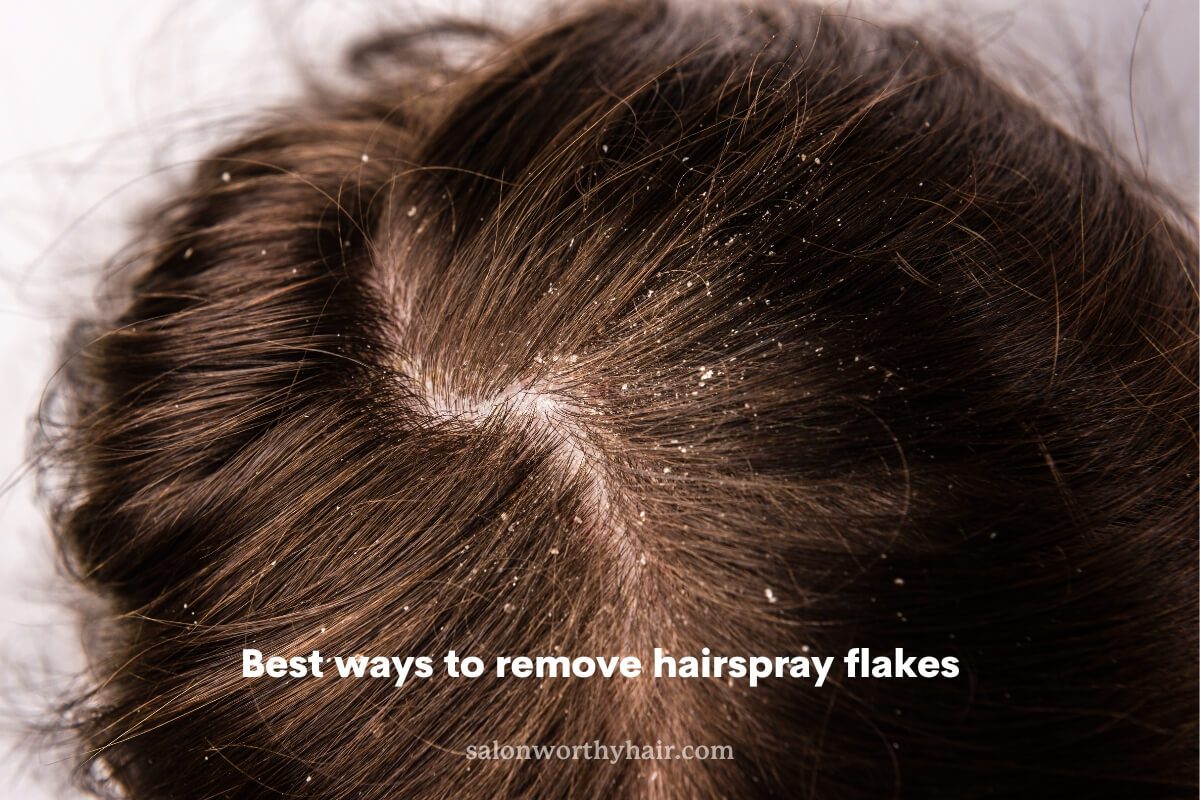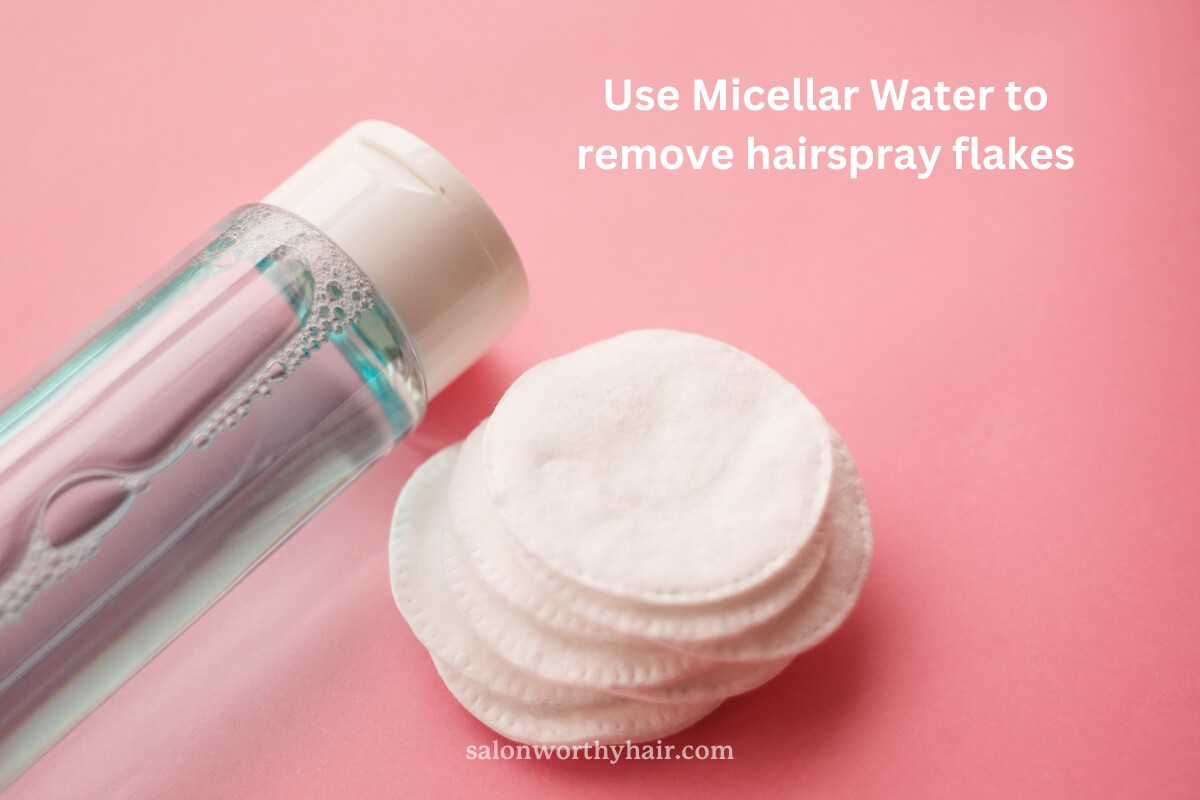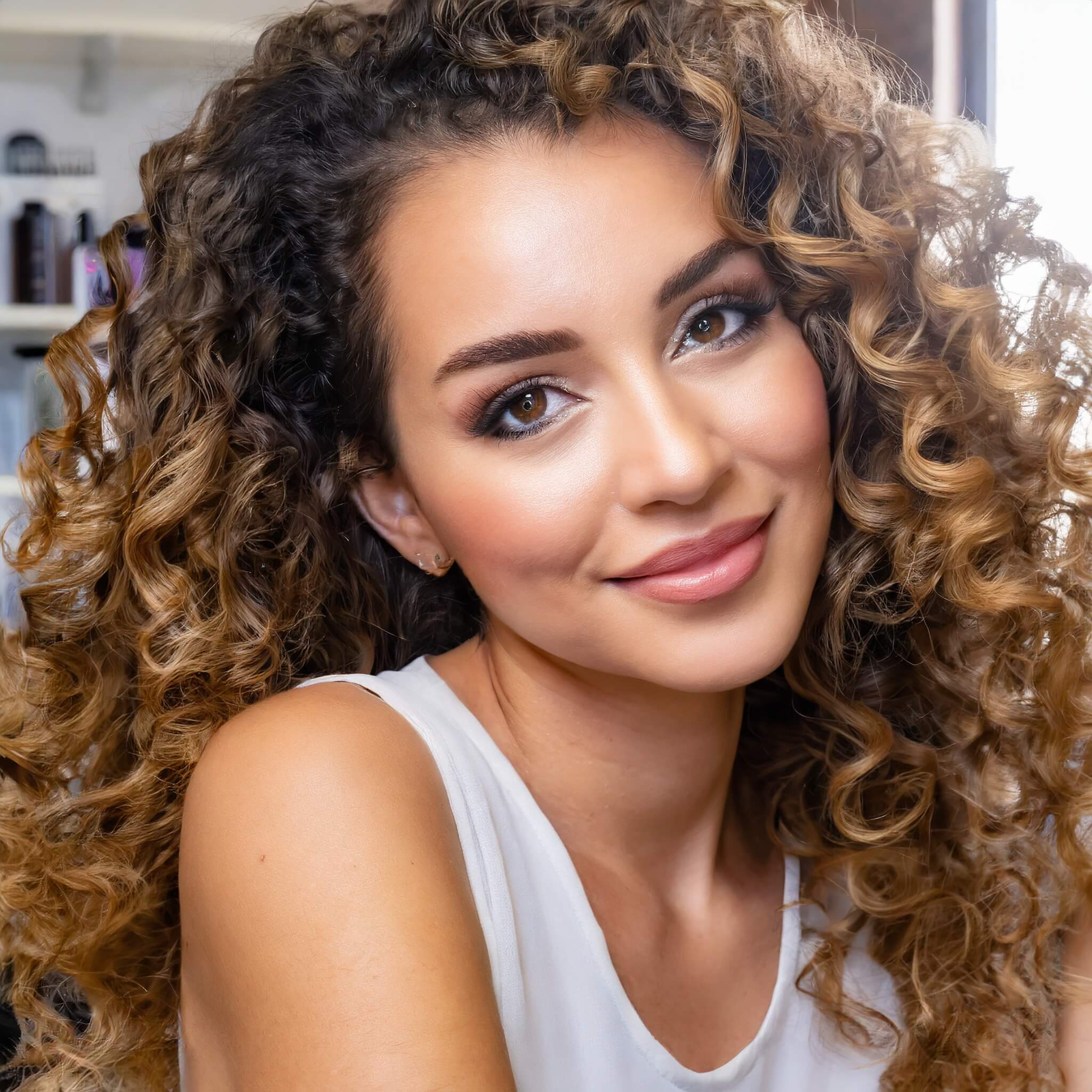How to Get Rid of Hairspray Flakes (7 Tips That Work)
Updated on
This post may contain affiliate links. As an Amazon Associate, we may earn from qualifying purchases.

While hairsprays offer the allure of holding your hairstyle in place, improper use or the wrong product can leave behind a trail of tiny, white flakes that resemble dandruff.
These flakes can cause embarrassment, frustration, and even self-consciousness, as they’re often mistaken for poor hygiene.
The problem stems from the very nature of hairsprays and how they work. Hairsprays are composed of various compounds, with the primary ones being polymers and solvents. The polymers are the agents that provide the ‘hold’ in hairsprays, while solvents (typically alcohol) keep these polymers in a sprayable form. When you spray the product onto your hair, the solvent evaporates, leaving behind the polymers to harden and secure your hairstyle.
The pesky flakes or hairspray dandruff arise when the polymers harden in the hair and are not rinsed out properly. This can occur for several reasons, such as spraying unevenly, too close, using too much product, or not shaking the can properly before use. These polymers break down into smaller particles, like dandruff littered across your scalp and hairline.
If you’re struggling with the dreaded hairspray flakes problem and cannot figure out how to get rid of them, let me show you 7 effective ways that work.

1. Use a Clarifying Shampoo
Clarifying shampoos are designed to deeply cleanse the hair and scalp, removing excessive buildup from the hair and scalp, including stubborn polymers left behind by hairsprays.
But how exactly do they work?
Regular shampoo contains mild surfactants that remove daily dirt and sebum without stripping the hair of its natural oils. However, hairspray polymers are more resistant to these mild surfactants. They require a deeper cleanse. Clarifying shampoos contain stronger surfactants like sulfates that can break down these stubborn residues to prevent them from clogging the hair follicles.
Use a clarifying shampoo at least once a week and follow up with a good conditioner or deep conditioning treatment to prevent dryness.
Recommended: Best clarifying shampoos.2. Use Micellar Water
Micellar water contains tiny spherical structures (micelles) formed by surfactant molecules, with a hydrophilic (water-attracting) exterior and a lipophilic (oil-attracting) interior.

The lipophilic core of the micelles attracts oil-based substances, like the polymers in hairspray. This allows the micelles to encapsulate and lift away the oil-based hairspray residues from the hair and scalp, effectively removing them when rinsed with water. The micellar water is gentle enough for frequent use, unlike other removal methods, making it a perfect choice for those with sensitive scalps or anyone looking for a milder alternative to clarifying shampoos.
Here are the steps on how to use micellar water to remove hairspray flakes:
- Apply a generous amount of micellar water directly to your hair and scalp.
- Massage it gently into your scalp and through your hair.
- Focus on areas with more buildup.
- Let it sit for a few minutes to allow the micelles to do their work.
- Rinse thoroughly with warm water.
- Follow up with your usual shampoo and conditioner routine.
Micellar water is gentle enough to be used more frequently than other methods. Once or twice a week should be sufficient for most individuals.
Aveda Rinseless Refresh
3. Do an Apple Cider Vinegar Rinse
The acidic nature of apple cider vinegar helps in two primary ways: it breaks down the hairspray buildup and restores the scalp’s pH balance.
Hairspray polymers are slightly alkaline. When ACV is applied, a neutralization reaction occurs, breaking down the polymer structure. This makes the residues easier to wash out, reducing flakiness.
ACV helps restore the pH balance of the scalp. Our scalp has a natural pH level of around 5.5, which alkaline hair products like hairsprays can disrupt. Restoring this pH balance helps maintain scalp health and prevent flaking.
Instructions on how to use apple cider vinegar to remove hairspray flakes:
- Mix equal parts of ACV and water in a spray bottle.
- After shampooing, spray this mixture onto your scalp and hair.
- Let it sit for a few minutes.
- Rinse thoroughly with warm water.
Use this rinse once a week for best results. Remember to avoid contact with the eyes, as ACV is acidic and can cause irritation.
dpHUE Apple Cider Vinegar Hair Rinse
4. Use Lemon Juice and Water
Lemon juice, rich in citric acid, works as a natural exfoliant for the scalp, effectively breaking down the adhesive properties of hairspray residue that cling to hair strands and the scalp. This acid loosens the bonds between the hairspray flakes and the hair, enabling them to be washed away more easily. Additionally, the acidity of lemon juice can help balance the pH of the scalp, which can be disrupted by the alkaline nature of hairspray.
To use lemon juice to remove hairspray flakes, follow these steps:
- Combine the juice of one fresh lemon with a cup of warm water in a spray bottle. The warmth of the water can help enhance the solvent properties of the mixture, further aiding in the breakdown of hairspray residue.
- Spray this mixture generously onto your scalp and hair, covering all areas with hairspray build-up.
- Leave it on for about 10 minutes. This allows enough time for the citric acid in the lemon juice to break down the hairspray flakes.
- Rinse your hair thoroughly with warm water. Follow with a gentle shampoo and conditioner to ensure all residue is completely washed away and your hair is left moisturized.
Caution:
The acidic nature of lemon juice can potentially dry out your hair and scalp if used excessively. Therefore, limit the use of this remedy to once a week. Avoid contact with eyes as the acidity of lemon juice can cause irritation. Lastly, lemon juice can lighten hair when exposed to the sun, so if you don’t want this effect, rinse it out before going outside.5. Use a Baking Soda Paste
Baking soda, or sodium bicarbonate, is a mild alkaline compound frequently used as a cleansing agent in home remedies due to its abrasive properties.
Hairspray polymers, as mentioned before, are slightly alkaline. Baking soda, being alkaline also, doesn’t neutralize the polymers but helps physically dislodge them. Its fine granules work as a gentle exfoliant, scrubbing the hardened polymer residues from the hair and scalp.
Here’s how to use baking soda to get rid of hairspray flakes:
- Mix one part baking soda with three parts water to form a paste.
- Apply this paste to your hair and scalp, focusing on areas with more buildup.
- Let it sit for a few minutes to loosen the hairspray residues.
- Rinse thoroughly.
- Follow with a mild shampoo and conditioner to restore moisture as baking soda can be drying.
Use this treatment no more than once a week; otherwise, it can result in overly dry hair. Always follow up with a conditioner to help rehydrate your hair after the baking soda treatment.
6. Use a Gentle Scalp Scrub
A scalp scrub is a type of hair care product that serves to exfoliate the scalp. The scalp scrub typically contains small particles or granules, such as sea salt or sugar, in a base of oil or gel. It works by gently massaging these particles into the scalp, helping to lift away dead skin cells, excess oil, and product buildup, including hairspray flakes.
The process works because the mechanical action of the scrubbing, combined with the exfoliating properties of the granules, breaks down and loosens the hairspray flakes that are adhering to the hair shaft and scalp. This makes them easier to be washed away during the rinsing process.
When using a scalp scrub, it’s important to apply the product onto damp hair and scalp, then gently massage it using circular motions. Be careful not to apply too much pressure to avoid irritation. Afterward, rinse thoroughly and follow up with your usual shampoo and conditioner. It’s recommended to use a scalp scrub once a week or every other week, depending on your hair type and needs.
The dpHUE Apple Cider Vinegar Scalp Scrub is a good product to try. It contains pink Himalayan sea salt, which exfoliates and removes buildup, and apple cider vinegar to balance scalp pH. It’s also infused with aloe vera and avocado oil to soothe and moisturize the scalp.
dpHUE Apple Cider Vinegar Scalp Scrub
7. Use a Hairbrush to Dislodge Flakes on Your Scalp
Brushing your hair can help remove hairspray flakes without washing the hair. A hairbrush creates mechanical action that dislodges and breaks down the particles of hairspray adhering to your hair strands and scalp.
When moved through the hair, the multiple bristles of a hairbrush cause friction against the hairspray flakes. This friction, combined with the force exerted by the bristles, disrupts the electrostatic and van der Waals forces holding the hairspray flakes onto your hair and scalp. As a result, the flakes are loosened and can be removed more easily.
Here’s how to use a hairbrush for removing hairspray flakes from your hair:
- Start by sectioning your hair.
- Hold a section taut and then gently brush from the roots to the tips.
- Repeat this process with all sections of your hair.
A boar bristle brush is recommended for best results. Its natural bristles are similar to human hair in structure, making them gentle yet effective at removing buildup. Plus, they help distribute natural oils from the scalp along the hair shaft, promoting healthier, shinier hair.
Denman Boar Bristle Brush
What Hairsprays Don’t Leave White Flakes?
Here’s how to find hairsprays that don’t cause flakes.
Look for:
- Alcohol-free.
- Polymer-free.
- No Butane.
- No Propane.
- Contain hydrating and soothing ingredients.
Here are 2 hairsprays that do not cause flakes:
Herbal Essences Bio:Renew Airspray
Color WOW Bombshell Volumizer
Tips for Preventing Hairspray Flakes
Here are 3 simple tips to prevent hairspray flakes:
- Shake well before use: Shaking the can well before use evenly disperse the active ingredients like polymers and solvents. This avoids ingredient clumping, which causes hairspray buildup and flakes.
- Spray from 10 – 12 inches away: Avoid spraying the product too close to the scalp. Spray from 10 – 12 inches away. This distance allows the hairspray to be evenly distributed across the hair without concentrating on certain areas.
- Use a hairbrush: Use a hairbrush to ensure the hairspray doesn’t clump in your hair.
And finally, make sure you follow a good hair care routine that includes a weekly clarifying shampoo and frequent brushing.
About the Author
 Camelia Smith
Camelia SmithCamelia Smith can color hair, perform keratin treatments, bleach hair, and even cut curly hair. She is our go-to person whenever we have hair treatments and styling questions.
She's also currently training as a freelance makeup artist and is passionate about helping others feel beautiful in their skin. When she's not writing or doing hair, she's usually spending time watching British period dramas.





